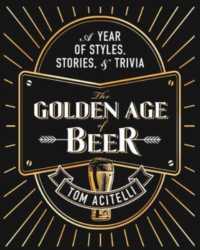Full Description
Evolution is a stochastic process, and given the amount of data generated in biological sciences today, there is a pressing need for people with a quantitative background to understand and contribute toward the understanding of evolution, leading to better interaction between stakeholders. This book equips engineers and physical scientists to make biologically relevant quantitative representations of evolutionary processes. The concepts of evolution are introduced via semi-quantitative treatment with graphical illustrations and explain how evolution experiments are conducted in a laboratory.
Features:
• Discusses background, concepts of evolutionary biology, and experimental evolution.
• Helps readers develop a geometric view of evolutionary processes.
• Covers both biological and mathematical foundations in equal measure.
• Illustrates coding exercises supported by pertinent MATLAB codes for the provided problems.
• Includes homework problems and a solutions manual.
This book is aimed at senior undergraduate and graduate students in engineering and physical sciences.
Contents
Contents
About the Author .......................................................................................................x
Preface.......................................................................................................................xi
Acknowledgments.................................................................................................. xiii
Chapter 1 The Theory of Evolution by Natural Selection....................................1
1.1 Introduction............................................................................... 1
1.2 Alfred Russell Wallace and Henry Bates ................................. 3
1.3 Charles Darwin and the Voyage of the Beagle ........................ 3
1.4 Wallace Goes Back to Sea........................................................ 5
1.5 Batesian Mimicry...................................................................... 7
1.6 Patrick Mathew - Solver of the Origin of Species Problem .... 7
1.7 Elements of the Theory of Natural Selection ........................... 8
1.8 Three Components of Natural Selection................................... 9
1.9 Fitness ..................................................................................... 10
1.10 Types of Selection .................................................................. 11
1.11 Limitations of Darwin's Proposal........................................... 15
1.12 Origin and Nature of Variation............................................... 18
1.13 Jenkin's Objections to Darwin's Ideas ................................... 18
1.14 Darwin's Response to the Criticisms...................................... 19
1.15 Conclusion .............................................................................. 20
Notes .................................................................................................. 21
Exercises ............................................................................................ 22
Bibliography....................................................................................... 23
Chapter 2 Primer on Central Dogma of Molecular Biology ..............................24
2.1 Introduction............................................................................. 24
2.2 Structure of DNA Molecule.................................................... 24
2.3 From DNA to Proteins............................................................ 28
2.4 Control of Gene Expression.................................................... 33
2.5 Alleles ..................................................................................... 35
2.6 Conclusion .............................................................................. 37
Notes .................................................................................................. 37
Exercises ............................................................................................ 38
Bibliography....................................................................................... 39
Chapter 3 Model Organism to Study Evolution.................................................40
3.1 Introduction............................................................................. 40
3.2 Evolution in Bacteria .............................................................. 40
3.3 Evolution in Sexually Reproducing Organisms ..................... 43
3.4 Our Choice of Model System................................................. 50
3.5 Conclusion .............................................................................. 50
Exercises ............................................................................................ 52
Bibliography....................................................................................... 52
Chapter 4 Growth Models...................................................................................53
4.1 Introduction............................................................................. 53
4.2 E. coli...................................................................................... 53
4.3 Growth in a Batch Culture...................................................... 54
4.4 Chemostat................................................................................ 59
4.5 Conclusion .............................................................................. 64
Notes .................................................................................................. 64
Exercises ............................................................................................ 65
Bibliography....................................................................................... 66
Chapter 5 Type of Mutations and Selection Coefficients...................................67
5.1 Introduction............................................................................. 67
5.2 Mutation Rate, m ..................................................................... 67
5.3 Mutations Are Rare................................................................. 67
5.4 Number of Generations in a Single Day ................................ 70
5.5 Types of Errors, and How Do These Errors Effect
Cell Function/Fitness?............................................................. 71
5.6 Fitness of a Genotype ............................................................. 74
5.7 What Is the Fitness Effect of Mutations? ............................... 75
5.8 Selection Coefficient ............................................................... 77
5.9 Conclusion .............................................................................. 79
Notes .................................................................................................. 79
Exercises ............................................................................................ 80
Bibliography....................................................................................... 81
Chapter 6 Fitness Landscapes.............................................................................82
6.1 Introduction............................................................................. 82
6.2 Sequence Space....................................................................... 82
6.3 Hamming Distance (H)........................................................... 83
6.4 Sequences with Hamming Distance Equal to One
Are of Special Interest ............................................................ 84
6.5 Connecting Sequences with H Equal to One ......................... 87
6.6 Putting Together Concepts to Understand Fitness
Landscape ............................................................................... 89
6.7 How Does a Fitness Landscape Help Visualize
Adaptation? ............................................................................. 90
6.8 What Is the Mode Value of Fitness on a Landscape?............ 92
6.9 Conclusion .............................................................................. 93
Notes .................................................................................................. 93
Exercises ............................................................................................ 94
Bibliography....................................................................................... 94
Chapter 7 Epistasis..............................................................................................96
7.1 Introduction............................................................................. 96
7.2 Epistasis in an Enzyme Pathway ............................................ 97
7.3 Implications of Epistasis on Evolutionary Dynamics........... 100
7.4 Modeling Epistasis (NK Model)........................................... 102
7.5 Conclusion ............................................................................ 104
Exercises .......................................................................................... 105
Bibliography..................................................................................... 106
Chapter 8 Drift ..................................................................................................107
8.1 Introduction........................................................................... 107
8.2 Marbles in a Jar..................................................................... 107
8.3 Analogy between 'Marbles in a Jar' and Evolutionary
Processes ............................................................................... 110
8.4 Drift in Experimental Evolution ........................................... 110
8.5 Moran Process....................................................................... 113
8.6 A Short Detour into Probability............................................ 115
8.7 Transition Probabilities ......................................................... 115
8.8 Conclusion ............................................................................ 121
Notes ................................................................................................ 121
Exercises .......................................................................................... 124
Bibliography..................................................................................... 125
Chapter 9 Clonal Interference ...........................................................................126
9.1 Introduction........................................................................... 126
9.2 Two Regimes ........................................................................ 126
9.3 Estimate of τw ....................................................................... 130
9.4 Estimate for τfix ..................................................................... 132
9.5 Traveling Wave Model ......................................................... 133
9.6 Speed of Adaptation ............................................................. 136
9.7 Conclusion ............................................................................ 139
Exercises .......................................................................................... 139
Bibliography..................................................................................... 139
Chapter 10 Distribution of Fitness Effects (DFE) ..............................................140
10.1 Introduction........................................................................... 140
10.2 What Is Distribution of Fitness Effects (DFE)? ................... 140
10.3 DFE of Deleterious Mutations.............................................. 145
10.4 Conclusion ............................................................................ 146
Exercises .......................................................................................... 146
Bibliography..................................................................................... 147
Chapter 11 The Idea of 'Molecular Clock' and Neutral Theory of
Molecular Evolution.........................................................................148
11.1 Introduction........................................................................... 148
11.2 A Problem to Solve............................................................... 150
11.3 Neutral Theory for Molecular Evolution.............................. 150
11.4 What Is dN
dS?............................................................................ 152
11.5 What Does dN
dS Tell Us? ......................................................... 157
11.6 Synonymous Mutations may be Non-Neutral ...................... 158
11.7 Conclusion ............................................................................ 161
Exercises .......................................................................................... 162
Bibliography..................................................................................... 162
Chapter 12 How to Do Evolution Experiments in Lab? ....................................164
12.1 Introduction........................................................................... 164
12.2 Why Use Bacteria to Study Evolution?................................ 164
12.3 Serial Sub-culture.................................................................. 167
12.4 Chemostat.............................................................................. 172
12.5 Mutation Accumulation (MA) Experiments......................... 173
12.6 Conclusion ............................................................................ 176
Exercises .......................................................................................... 176
Bibliography..................................................................................... 177
Chapter 13 Lessons from Evolution Experiments: The Long-Term Evolution
Experiment (LTEE)..........................................................................178
13.1 Introduction........................................................................... 178
13.2 LTEE's Experimental Design ............................................... 179
13.3 Phenomenology of Adaptation in LTEE .............................. 180
13.4 Genetic Basis of Adaptation ................................................. 186
13.5 Evolution of Novelty in LTEE ............................................. 188
13.6 Conclusion ............................................................................ 189
Notes ................................................................................................ 190
Exercises .......................................................................................... 190
Bibliography..................................................................................... 190
Chapter 14 Lessons from Evolution Experiments ..............................................192
14.1 Introduction........................................................................... 192
14.2 Evolution of Multicellularity ................................................ 193
14.3 Evolution of Bet-hedging...................................................... 195
14.4 Phenotypic Diversification.................................................... 199
14.5 Gene duplication and Adaptive Divergence......................... 200
14.6 Megaplate Resistance Evolution........................................... 202
14.7 Directed Evolution ................................................................ 204
14.8 Conclusion ............................................................................ 205
Exercises .......................................................................................... 205
Bibliography..................................................................................... 205
Chapter 15 Empirical Fitness Landscapes ..........................................................207
15.1 Introduction........................................................................... 207
15.2 Case I: β-lactamase and Antibiotic Resistance in E. coli..... 207
15.3 Case II: Long-Term Evolution Experiment (LTEE)............. 210
15.4 Case III: folA Landscape in E. coli....................................... 211
15.5 Conclusion ............................................................................ 213
Exercises .......................................................................................... 213
Bibliography..................................................................................... 214
Chapter 16 What Have We Not Discussed?.......................................................215
16.1 Introduction........................................................................... 215
16.2 Horizontal Gene Transfer ..................................................... 215
16.3 Speciation.............................................................................. 216
16.4 Pleiotropy .............................................................................. 217
16.5 Conclusion ............................................................................ 217
Bibliography..................................................................................... 218
Index......................................................................................................................219






